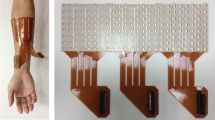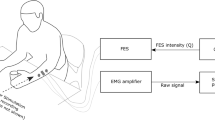Abstract
The use of electromyography (EMG) for the control of upper-limb prostheses has received great interest in neurorehabilitation engineering since decades. Important advances have been performed in the development of machine learning algorithms for myocontrol. This paper describes a novel adaptive filter for EMG preprocessing to be applied as conditioning stage for optimal subsequent information extraction. The aim of this filter is to improve both the quality (signal-to-noise ratio) and the selectivity of the EMG recordings. The filter is based on the classic common average reference (CAR), often used in EEG processing. However, while CAR is stationary, the proposed filter, which is referred to as adaptive common average reference (ACAR), is signal-dependent and its spatial transfer function is adapted over time. The ACAR filter is evaluated in this study for noise reduction and selectivity. Furthermore, it is proven that its application improves the performance of both pattern recognition and regression methods for myoelectric control. It is concluded that the proposed novel filter for EMG conditioning is a useful preprocessing tool in myocontrol applications.









Similar content being viewed by others
References
Broman H, Bilotto G, De Luca CJ (1985) A note on the noninvasive estimation of muscle fiber conduction velocity. IEEE Trans Biomed Eng 32:341–344. doi:10.1109/TBME.1985.325550
Bunderson NE, Kuiken TA (2012) Quantification of feature space changes with experience during electromyogram pattern recognition control. IEEE Trans Neural Syst Rehabil Eng 20:239–246. doi:10.1109/TNSRE.2011.2182525
De Luca CJ, Merletti R (1988) Surface myoelectric signal cross-talk among muscles of the leg. Electroencephalogr Clin Neurophysiol 69:568–575. doi:10.1016/0013-4694(88)90169-1
Disselhorst-Klug C, Silny J, Rau G (1997) Improvement of spatial resolution in surface-EMG: a theoretical and experimental comparison of different spatial filters. IEEE Trans Biomed Eng 44:567–574. doi:10.1109/10.594897
Fougner A, Stavdahl O, Kyberd PJ et al (2012) Control of upper limb prostheses: terminology and proportional myoelectric control-a review. IEEE Trans Neural Syst Rehabil Eng 20:663–677. doi:10.1109/TNSRE.2012.2196711
Hahne JM, Graimann B, Müller K-R (2012) Spatial filtering for robust myoelectric control. IEEE Trans Biomed Eng 59:1436–1443. doi:10.1109/TBME.2012.2188799
Hahne JM, Rehbaum H, Biessmann F et al (2012) Simultaneous and proportional control of 2D wrist movements with myoelectric signals. 2012 IEEE International workshop on machine learning and signal processing, pp 1–6
Hargrove LJ, Li G, Englehart KB, Hudgins BS (2009) Principal components analysis preprocessing for improved classification accuracies in pattern-recognition-based myoelectric control. IEEE Trans Biomed Eng 56:1407–1414. doi:10.1109/TBME.2008.2008171
Hudgins B, Parker P, Scott RN (1993) A new strategy for multifunction myoelectric control. IEEE Trans Biomed Eng 40:82–94. doi:10.1109/10.204774
Jiang N, Dosen S, Muller K-R, Farina D (2012) Myoelectric control of artificial limbs—is there a need to change focus? [in the spotlight]. IEEE Signal Process Mag 29:152–160. doi:10.1109/MSP.2012.2203480
Jiang N, Rehbaum H, Vujaklija I et al (2013) Intuitive, online, simultaneous and proportional myoelectric control over two degrees of freedom in upper limb amputees. IEEE Trans Neural Syst Rehabil Eng. doi:10.1109/TNSRE.2013.2278411
Kinder MV, van Waalwijk van Doorn ES, Gommer ED, Janknegt RA (1998) A non-invasive method for bladder electromyography in humans. Arch Physiol Biochem 106:2–11. doi:10.1076/apab.106.1.2.4393
Koh TJ, Grabiner MD (1993) Evaluation of methods to minimize cross talk in surface electromyography. J Biomech 26(Suppl 1):151–157
McFarland DJ, McCane LM, David SV, Wolpaw JR (1997) Spatial filter selection for EEG-based communication. Electroencephalogr Clin Neurophysiol 103:386–394. doi:10.1016/S0013-4694(97)00022-2
Merletti R, Aventaggiato M, Botter A et al (2010) Advances in surface EMG: recent progress in detection and processing techniques. Crit Rev Biomed Eng 38:305–345
Mewett DT, Nazeran H, Reynolds KJ (2001) Removing power line noise from recorded EMG. In: IEEE 2001 proceedings of 23rd Annual international conference of IEEE engineering, medicine, biological society, pp 2190–2193
Ramoser H, Müller-Gerking J, Pfurtscheller G (2000) Optimal spatial filtering of single trial EEG during imagined hand movement. IEEE Trans Rehabil Eng 8:441–446
Rehbaum H, Jiang N, Paredes L et al (2012) Real time simultaneous and proportional control of multiple degrees of freedom from surface EMG: preliminary results on subjects with limb deficiency. Conf Proc IEEE Eng Med Biol Soc 2012:1346–1349. doi:10.1109/EMBC.2012.6346187
Van Vugt J, Van Dijk J (2001) A convenient method to reduce crosstalk in surface EMG. Clin Neurophysiol 112:583–592
Zecca M, Micera S, Carrozza MC, Dario P (2002) Control of multifunctional prosthetic hands by processing the electromyographic signal. Crit Rev Biomed Eng 30:459–485. doi:10.1615/CritRevBiomedEng.v30.i456.80
Zhou P, Lock B, Kuiken TA (2007) Real time ECG artifact removal for myoelectric prosthesis control. Physiol Meas 28:397–413. doi:10.1088/0967-3334/28/4/006
Acknowledgments
This work is financed by the European Commission via the Industrial Academia Partnerships and Pathways (IAPP), Grant No. 251555 (AMYO).
Author information
Authors and Affiliations
Corresponding author
Rights and permissions
About this article
Cite this article
Rehbaum, H., Farina, D. Adaptive common average filtering for myocontrol applications. Med Biol Eng Comput 53, 179–186 (2015). https://doi.org/10.1007/s11517-014-1215-1
Received:
Accepted:
Published:
Issue Date:
DOI: https://doi.org/10.1007/s11517-014-1215-1




